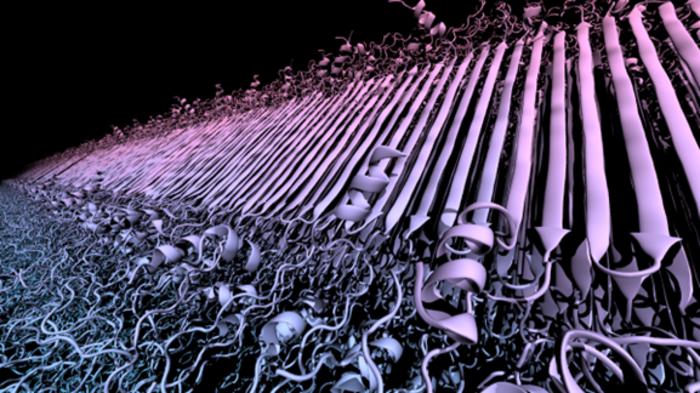In groundbreaking research published in Nature Communications, a team of interdisciplinary scientists led by Markus Miettinen from the University of Bergen has unveiled an intricate depiction of protein clumps that are pivotal in the progression of Huntington’s disease. This neurodegenerative disorder, characterized by a hereditary mutation that frequently leads to significant cognitive and motor decline, is underscored by the aggregation of misfolded proteins. Deciphering the structural components of these clumps could hold the key to innovative diagnostic strategies and treatment avenues, offering a glimmer of hope for those affected by this unforgiving illness.
The collaborative effort brought together experts from various prestigious institutions across Europe, showcasing a blend of methodologies that meld theoretical and experimental approaches in structural biology. For the first time, the detailed atomic structure of mutant huntingtin fibrils—pertinent to the pathological hallmarks of Huntington’s disease—has been resolved, enhancing our understanding of the molecular mechanisms that underlie disease progression. The implications of this study are far-reaching, potentially influencing both the development of targeted therapies and the creation of new diagnostic tools to monitor disease advancement.
Huntington’s disease affects individuals in the prime of their lives, generally manifesting in mid-adulthood and leading to a gradual decline in one’s abilities. Historical research has hinted at the pivotal role that protein aggregation plays in both the etiological and symptomatic facets of the disease; however, precise knowledge regarding the configuration of these aggregates has remained elusive until now. Miettinen’s research group employs an innovative integrative approach, merging advanced computer modeling and state-of-the-art experimental techniques to generate comprehensive insights into the atomic structure of these significant protein clumps.
A notable aspect of this research lies in its interdisciplinary nature. By bridging the divide between computational simulations and empirical observations, Miettinen and his colleagues have made significant strides in transforming raw data into meaningful biological insights. This synergy not only yields new understanding but also develops accessible methodologies for researchers across the globe, aiming to foster a more nuanced comprehension of complex biomolecular systems. This emphasis on collaboration echoes the current trend in scientific inquiry, where shared knowledge across specializations accelerates discovery.
The methodologies utilized in this study exemplify the evolving landscape of structural biology. By capturing a detailed visualization of the mutant huntingtin fibrils, the researchers have set a new precedent for how diseases characterized by protein aggregation can be studied. Their results highlight the unique structural properties of the clumps associated with Huntington’s disease, which differ fundamentally from those observed in other neurodegenerative disorders such as Alzheimer’s and Parkinson’s diseases. These distinctions raise intriguing questions about the mechanisms underlying the formation and stability of these aggregates, hinting at diverse pathways implicated in various protein misfolding diseases.
Moreover, the findings present an opportunity to explore the potential for innovative therapeutic interventions that target specific structural attributes of these aggregates. Understanding how the structural variations among different protein aggregates correlate with pathological outcomes could provide leverage in the design of molecule-based therapies aimed at reversing or halting the progression of Huntington’s disease. Current pharmacological strategies predominantly focus on symptomatic relief; however, this research illustrates a future where structural insights guide the development of disease-modifying treatments.
The urgency of these insights becomes palpable when considering the broader context of neurodegenerative diseases. With an aging population and increasing prevalence of disorders like Huntington’s, the demand for effective diagnostic and therapeutic strategies grows more pressing. The work of Miettinen and his collaborators underscores a movement toward proactive healthcare strategies that emphasize early detection and intervention. By advancing our understanding of protein structures and their functional implications, their research contributes significantly to this imperative.
Furthermore, the funding landscape for such pioneering research is critical. The project received broad support from institutions and foundations that are dedicated to advancing the understanding of Huntington’s disease. Financial backing from communities impacted by the disease reflects a societal recognition of the importance of basic research in the pursuit of therapeutic breakthroughs. The engagement of advocacy groups not only provides essential funding but also fosters a community-oriented approach to scientific endeavors, connecting the research with the experiences of those affected.
As Miettinen articulates, the goal is not only to uncover new insights into Huntington’s disease but also to create frameworks that empower future researchers. By developing tools to enhance the accessibility of molecular simulations, the team hopes to catalyze further exploration into the structural biology of various neurodegenerative diseases. As these tools become more widely available, the potential for collaborative and cross-disciplinary research increases, fostering a richer understanding of complex diseases that have historically resisted definitive treatments.
In conclusion, the research conducted by Miettinen and his team offers a remarkable contribution to the field of structural biology and disease research. As they unveil the intricate atomic structures pertinent to Huntington’s disease, the promise of new diagnostic and therapeutic avenues emerges. Their work not only pushes the boundaries of our understanding but also establishes a collaborative framework that could reshape research methodologies in biomedical science, particularly in the realm of neurodegenerative diseases. As the scientific community grapples with these pressing issues, the hope remains that such pioneering insights will eventually lead to meaningful advancements in patient care.
Through this dynamic confluence of expertise and innovative methodologies, Miettinen et al. stand at the forefront of a new era in Huntington’s disease research, paving the way for transformative breakthroughs that have the potential to significantly enhance patient outcomes and health strategies worldwide.
Subject of Research: Protein clumps associated with Huntington’s disease
Article Title: Integrative determination of atomic structure of mutant huntingtin exon 1 fibrils implicated in Huntington disease
News Publication Date: 30-Dec-2024
Web References: Nature Communications
References: DOI 10.1038/s41467-024-55062-8
Image Credits: Markus Miettinen, UiB/CBU.
Keywords: Huntington’s disease, protein aggregates, structural biology, neurodegenerative diseases, research collaboration.






